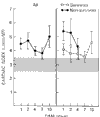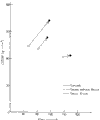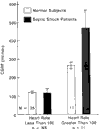Clinical review: Myocardial depression in sepsis and septic shock
- PMID: 12493071
- PMCID: PMC153435
- DOI: 10.1186/cc1822
Clinical review: Myocardial depression in sepsis and septic shock
Abstract
Myocardial dysfunction frequently accompanies severe sepsis and septic shock. Whereas myocardial depression was previously considered a preterminal event, it is now clear that cardiac dysfunction as evidenced by biventricular dilatation and reduced ejection fraction is present in most patients with severe sepsis and septic shock. Myocardial depression exists despite a fluid resuscitation-dependent hyperdynamic state that typically persists in septic shock patients until death or recovery. Cardiac function usually recovers within 7-10 days in survivors. Myocardial dysfunction does not appear to be due to myocardial hypoperfusion but due to circulating depressant factors, including the cytokines tumor necrosis factor alpha and IL-1beta. At a cellular level, reduced myocardial contractility seems to be induced by both nitric oxide-dependent and nitric oxide-independent mechanisms. The present paper reviews both the clinical manifestations and the molecular/cellular mechanisms of sepsis-induced myocardial depression.
Figures






Similar articles
-
[Myocardial dysfunction and septic shock].Med Sci (Paris). 2004 Dec;20(12):1115-8. doi: 10.1051/medsci/200420121115. Med Sci (Paris). 2004. PMID: 15581466 Review. French.
-
Myocardial dysfunction in the patient with sepsis.Curr Opin Crit Care. 2002 Oct;8(5):376-88. doi: 10.1097/00075198-200210000-00003. Curr Opin Crit Care. 2002. PMID: 12357104 Review.
-
Cardiac dysfunction in severe sepsis and septic shock.Curr Opin Crit Care. 2009 Oct;15(5):392-7. doi: 10.1097/MCC.0b013e3283307a4e. Curr Opin Crit Care. 2009. PMID: 19633546 Review.
-
Pathophysiology of cardiovascular dysfunction in septic shock.New Horiz. 1998 May;6(2):130-8. New Horiz. 1998. PMID: 9654320 Review.
-
Sepsis-induced cardiomyopathy: a review of pathophysiologic mechanisms.Heart Fail Rev. 2010 Nov;15(6):605-11. doi: 10.1007/s10741-010-9176-4. Heart Fail Rev. 2010. PMID: 20571889 Review.
Cited by
-
Levosimendan Versus Dobutamine in Myocardial Injury Patients with Septic Shock: A Randomized Controlled Trial.Med Sci Monit. 2016 May 3;22:1486-96. doi: 10.12659/msm.898457. Med Sci Monit. 2016. PMID: 27138236 Free PMC article. Clinical Trial.
-
Unraveling the Intricate Roles of Exosomes in Cardiovascular Diseases: A Comprehensive Review of Physiological Significance and Pathological Implications.Int J Mol Sci. 2023 Oct 27;24(21):15677. doi: 10.3390/ijms242115677. Int J Mol Sci. 2023. PMID: 37958661 Free PMC article. Review.
-
Strain Echocardiography Parameters Correlate With Disease Severity in Children and Infants With Sepsis.Pediatr Crit Care Med. 2016 May;17(5):383-90. doi: 10.1097/PCC.0000000000000683. Pediatr Crit Care Med. 2016. PMID: 26963758 Free PMC article.
-
Efficacy and safety of phospholipid nanoparticles (VBI-S) in reversing intractable hypotension in patients with septic shock: a multicentre, open-label, repeated measures, phase 2a clinical pilot trial.EClinicalMedicine. 2024 Jan 29;68:102430. doi: 10.1016/j.eclinm.2024.102430. eCollection 2024 Feb. EClinicalMedicine. 2024. PMID: 38545092 Free PMC article.
-
Brain natriuretic peptide for prediction of mortality in patients with sepsis: a systematic review and meta-analysis.Crit Care. 2012 May 6;16(3):R74. doi: 10.1186/cc11331. Crit Care. 2012. PMID: 22559153 Free PMC article.
References
-
- Center for Diseases Control and Prevention National Center for Health Statistics: mortality patterns – United States, 1990. Monthly Vital Stat Rep. 1993;41:5.
-
- Angus DC, Linde-Zwirble WT, Lidicker J, Clermont G, Carcillo J, Pinsky MR. Epidemiology of severe sepsis in the United States: analysis of incidence, outcome and associated costs of care. Crit Care Med. 2001;29:1303–1310. - PubMed
-
- Bone RC, Balk RA, Cerra FB, Dellinger RP, Fein AM, Knaus WA, Schein RM, Sibbald WJ. Definitions for sepsis and organ failure and guidelines for the use of innovative therapies in sepsis. Chest. 1992;101:1644–1655. - PubMed
-
- Van der Poll T, Van Deventer JH. Cytokines and anticytokines in the pathogenesis of sepsis. Infect Dis Clin North Am. 1999;13:413–426. - PubMed
Publication types
MeSH terms
Substances
LinkOut - more resources
Full Text Sources
Other Literature Sources
Medical

